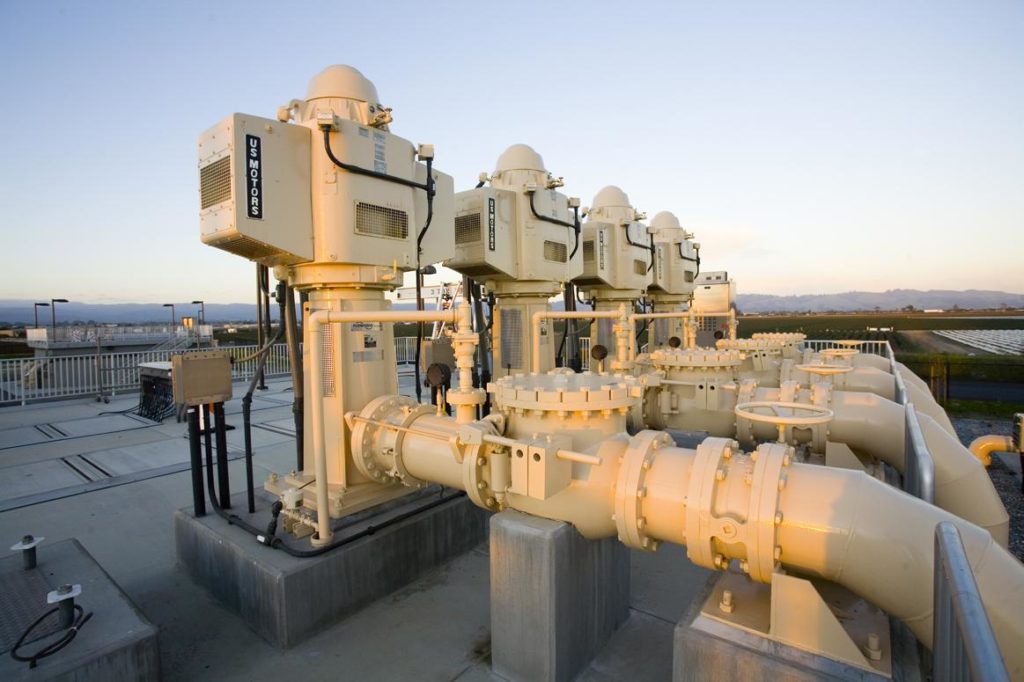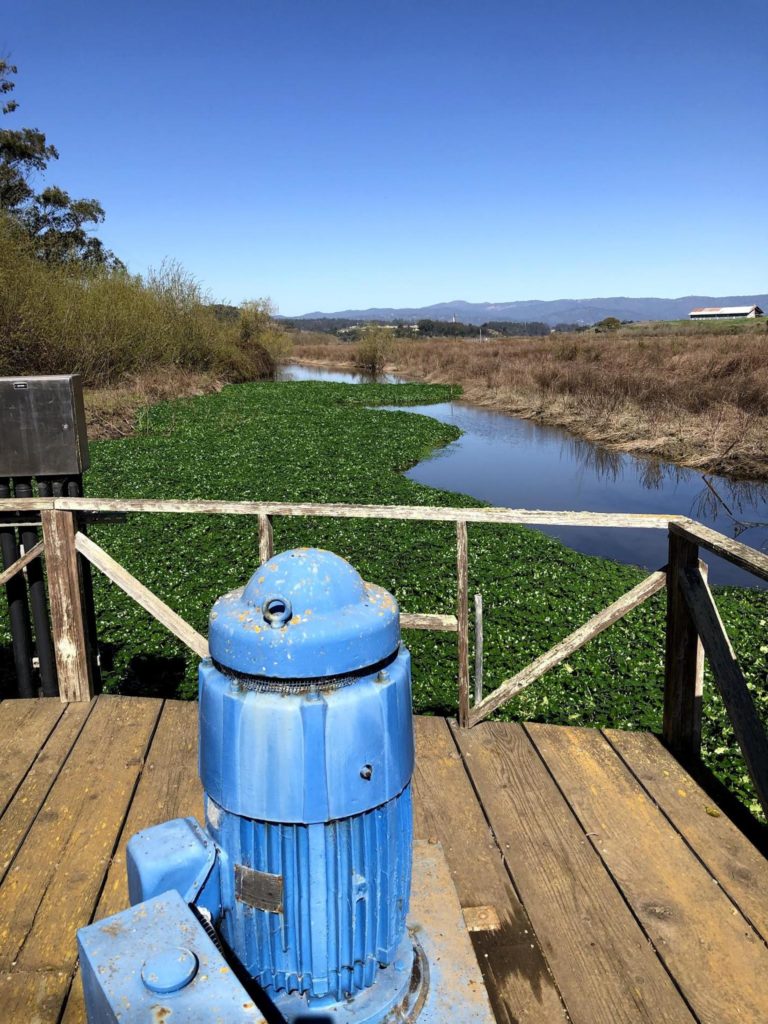
The Pajaro Valley enjoys a temperate microclimate, in part because it is situated at the hip of Monterey Bay. It lays like an east-west-oriented horseshoe, with the open end settling around the coastal plains of Elkhorn Slough and its various tributaries and side sloughs. Rimmed by the Santa Cruz Mountains to the north, the Gabilan Range to the south, and the San Andreas Fault at its head, the Pajaro Valley is a unique place in California.
Marks from the state’s past — traces of the indigenous creekside camps to the Mission landmarks and Gold Rush-era place-names — tell part of the valley’s story. Unlike in neighboring areas that have embraced the commuting car culture, the endless lines of perfectly aligned row crops reveal that this valley is still very much a working landscape.
But the Pajaro Valley is different from the rest of the big ag regions in California. The loamy soil isn’t irrigated with massive surface water infrastructure like in the Central Valley. “There are no federal or state water projects here,” says Marcus Mendiola, a water conservation and outreach specialist with the Pajaro Valley Water Management Agency. Nevertheless, the 28,500 acres of well-tended crops in the lower Pajaro watershed are planted in what is considered among the most valuable agricultural land on the planet.
The farms that create the economic engine of Pajaro Valley operate at different scales. Some growers are small, while others have labels you might recognize from the grocery store: Martinellis, Driscolls, California Giant, to name a few. Regardless of the amount of acreage under management, one thing that the farmers (and all residents, for that matter) share is that most of their water comes from the ground.
How to best handle the area’s diminishing supply of groundwater has occupied local water managers for decades. “People have been documenting groundwater concerns here since the 1950s,” says Mendiola. But improvements to conservation and infrastructure — funded in part by California’s 18-year old Integrated Regional Water Management program — have bolstered the valley’s chances of thriving in the face of future stresses like climate change and seawater intrusion.
Like cairns that show the way on a faint trail, the coastal distribution pipeline operated by the Pajaro Valley Water Management Agency and serving 5,000 acres of prime farmland is marked every so often by turnouts. The turnouts pop above ground as six-to-eight-inch-diameter pipe and then bend at 90 degrees. They are affixed with a series of valves (and usage meters, which are in the process of being converted from hand-read manual meters to digital meters). The turnouts allow irrigators to connect to a vast system of water infrastructure managed by the agency, known locally as PV Water.
PV Water was created in 1984 by state charter to deal with the valley’s diminishing water supply. The agency is solely focused on the conservation and management of groundwater for irrigation, which accounts for 85 percent of the water demand in the valley.
“The entire geology of this area is like a layer cake,” says Mendiola. Historically, the recharge rate of the layer-cake-like aquifer used to keep pace with the withdrawal rate. So much so that valley old-timers remember when wells near the coast would run artesian, which means that the aquifer was so full that when tapped, water would come to the surface without pumping, Mendiola says. But in more recent decades in the Pajaro Valley, like in much of California, the demand for water has exceeded the supply, meaning the level of available water in the aquifer was continually receding.
The color of PV Water’s turnouts and wellheads along the 21 miles of the coastal distribution pipeline system is significant. Blue paint means that the valves connect to a well underneath the ground. The health of these wells — both quality and quantity (salinity is a major concern) — is managed through recharge efforts. For the past two decades, PV Water has been experimenting with new ways of increasing natural recharge (or allowing water to percolate through the ground, which filters the water and raises the level of the underlying aquifer) across its jurisdiction.
In 2002, one of PV Water’s first major infrastructure projects came online. They retrofitted equipment that Santa Cruz County once used to dewater cropland and now use it to pump water — permitted up to 2,000 acre-feet a year and only when the water quality and quantity meet certain thresholds — into a recharge basin a mile-and-a-half away. This time of year, ducks love the recharge pond, which is in the middle of what feels like endless fields of just-ripening strawberries. Underground it’s refilling local aquifers. “After all, the best and most efficient place to store water,” Mendiola says, “is underground.”
Here and there on the horizon, purple turnouts are visible. Purple means the water is coming from a recycling facility. Opened in 2009, and continually improved since, the Watsonville Area Water Recycling Facility helps PV Water manage for both agricultural output and a healthy aquifer. By using water recycled from Watsonville’s municipal wastewater plant, the agency is able to offset some of the demand for groundwater. “The groundwater creates a hydrostatic barrier, which prevents further seawater intrusion,” Mendiola says.
As an added benefit, further treating water coming from the wastewater facility and sending it back to the fields as high-quality, non-potable water reduces the need to send the nutrient-rich water through a discharge pipe into Monterey Bay. For the last 14 years, PV Water has been monitoring nutrient loading of soil and groundwater in their recycled water delivery area. “We have not observed a negative impact to the soils from recycled water deliveries,” Mendiola says.

The water diverted into the recycling facility averages about 57 percent (or about 6,000 acre feet) of Watsonville’s wastewater over the course of a year. During peak dry times as much as 100 percent of Watsonville’s discharge is recycled according to Mendiola. In three concrete structures, the recycled water goes through additional processing steps including more solid separation, filtration, and disinfection, and blended with other water sources before entering PV Water’s coastal distribution system and made available to irrigators.
The system has worked so well that it was expanded in 2014 to include an additional 1.5-million-gallon storage tank to keep up with demand. The new tank, as well as the recycling facility itself (which today is under construction to add additional filtration), was funded in part because recurring droughts led California to make a priority of promoting more integrated regional water management in the early 2000s.
First launched in 2002, Integrated Regional Water Management (IRWM) alleviates some of the burden of managing California’s complicated water situation. A collaborative effort led by the Department of Water Resources, IRWM is an organizational structure designed to get water-related funding earmarked via bond measures prioritized and delivered to water-related projects around the state. So far, the department has awarded $1.5 billion in IRWM grants for infrastructure, education, conservation, and access.

The goal is to better coordinate water-related expertise, data, and funding across jurisdictional, watershed, and political boundaries to concurrently achieve social, environmental, and economic benefits, explains James Muller, principal environmental planner with the San Francisco Estuary Partnership and the grant manager for 39 projects under three IRWM grants in the Bay Area.
IRWM divides the state into 12 funding regions that are allocated a discrete share of the total IRWM funding made available by bond propositions. The Department of Water Resources solicits proposals from these funding regions that must meet an arduous set of eligibility criteria.
The Watsonville Area Recycling Center received several rounds of funding under Proposition 84 including $4.7 million to build the coastal distribution pipeline, $6.8 million to build the recycled water facility, and $900,000 to build the 1.5-million-gallon storage tank. While the money did help get those projects built, IRWM funds represent only a portion of the total construction and maintenance costs for most large-scale projects. “You also see projects that would never happen unless they were funded by a program like IRWM,” says Muller.
“It’s been good,” says Brian Lockwood, general manager of PV Water, about the IRWM process. “It’s definitely developed increased collaboration. It makes you think and work together at a more regional scale, instead of only working in your own box.”
And the work continues. While Lockwood is concerned that the tap of IRWM funds might not be flowing as steadily as in previous years, the agency is still using IRWM money to expand the availability of recycled water for irrigation.
In Pajaro Valley, PV Water will break ground soon on an addition to the coastal delivery system, bringing more recycled water to more farms to the north. The project is funded by $3 million in IRWM funds. “We’ll be able to add two miles to our 21 miles of the existing coastal distribution pipeline,” Lockwood says.
Coastal Water Distribution System
Bay Area Integrated Regional Water Management
Top Photo: A purple turnout delivering recycled water to some of Pajaro Valley’s valuable farmland. Photo: PV Water